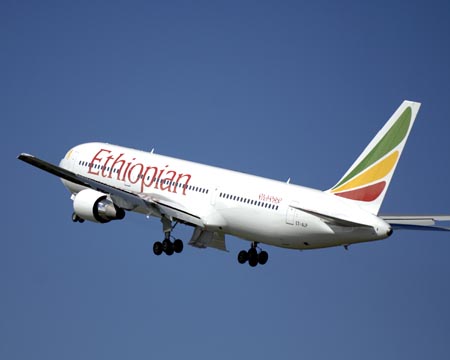The full picture of what happened in the cockpit of Ethiopian Airlines 737 MAX Flight 302 on March 10 is emerging from a preliminary report and a newly released data plot showing how crew and technology interacted.
The airline’s youngest-ever captain, a 29-year-old with an impressive 8,100 hours flying time, and his rookie 25-year-old co-pilot may have made a crucial mistake by leaving the engines at full take-off power, according to data and other pilots.
By the end, the aircraft was traveling at 500 knots (575 mph, 926 kph), far beyond its design limits.
That and some other potential missteps may have left them unable to fight flawed Boeing software that eventually sent the jet into an uncontrollable dive, experts said after studying the data.
A sudden data spike suggests a bird hit the plane as it was taking off and sheared away a vital airflow sensor.
As with the Lion Air crash in Indonesia, the damaged ‘angle of attack’ sensor, which tells pilots what angle the aircraft has relative to its forward movement, may have set off a volatile chain of events.
In both cases, the faulty sensor tricked the plane’s computer into thinking the nose was too high and the aircraft was about to stall, or lose lift. The anti-stall MCAS software then pushed the nose down forcefully with the aircraft’s “trim” system, normally used to maintain level flight.
The first time the MCAS software kicked in, the Ethiopian Airlines pilots quickly countered the movement by flicking switches under their thumbs – they had recognized the movements as the same type all flight crews had been warned about after the Lion Air flight.
But data suggest they did not hold the buttons down long enough to fully counteract the computer’s movements. At that point, they were a mere 3,000 feet above the airport, so low that a new warning – a computerized voice saying “don’t sink” – sounded in the cabin.
The bird strike and loss of airflow data would have affected airspeed information too. In such cases, pilots know to turn off automatic engine settlings and control thrust manually.
But the report says “the throttles did not move,” without elaborating. Data confirms the engines stayed at nearly full power. Other 737 pilots say that made the crew’s job tougher by making the controls much harder to move.
The Ethiopian Airlines crash, and another in Indonesia five months earlier, have left the world’s largest planemaker in crisis as its top-selling jetliner is grounded worldwide, and Ethiopia scrambling to protect one of Africa’s most successful companies.
Boeing is working on a software fix for MCAS and extra pilot training, which its chief executive, Dennis Muilenburg, said would prevent similar events from happening again.

 Uncategorized7 days ago
Uncategorized7 days ago
 Business1 week ago
Business1 week ago
 Business6 days ago
Business6 days ago
 Politics3 days ago
Politics3 days ago
 News3 days ago
News3 days ago
 Crime5 days ago
Crime5 days ago
 Latest5 days ago
Latest5 days ago
 Business5 days ago
Business5 days ago

